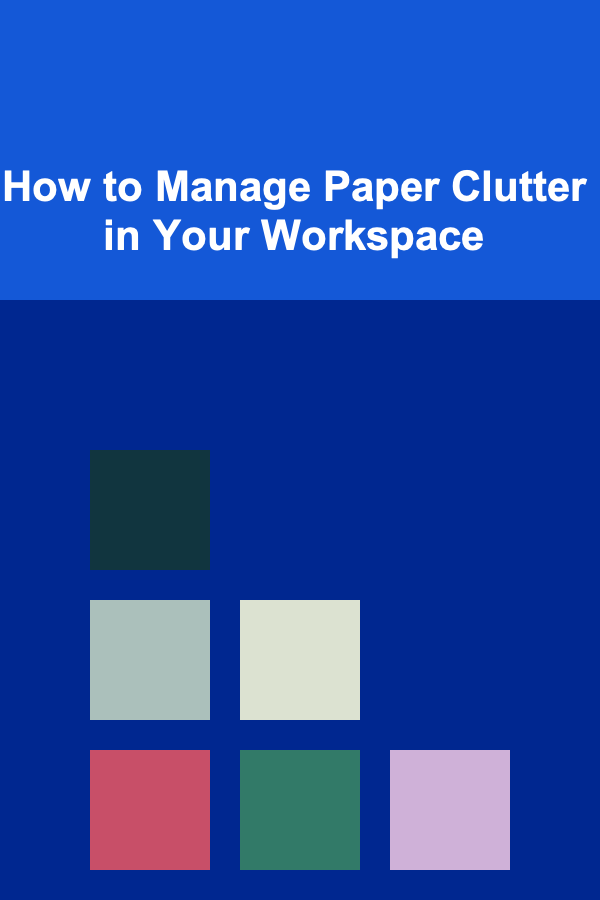
How to Manage Paper Clutter in Your Workspace
ebook include PDF & Audio bundle (Micro Guide)
$12.99$7.99
Limited Time Offer! Order within the next:

In today's digital age, the irony of paper clutter remains prevalent. Even with an increasing reliance on technology, physical documents still pile up in offices and workspaces, leading to chaos and inefficiency. Managing paper clutter is crucial for maintaining productivity, reducing stress, and creating a conducive working environment. This comprehensive guide will explore effective strategies for managing paper clutter in your workspace, offering practical tips, systems, and techniques to declutter and maintain organization.
Understanding the Impact of Paper Clutter
1. Decreased Productivity
Paper clutter can significantly hinder productivity. When documents are disorganized, finding what you need becomes time-consuming, leading to distractions and frustration. This inefficiency can detract from your overall output and effectiveness.
2. Increased Stress Levels
A cluttered workspace can contribute to feelings of overwhelm and anxiety. The sight of piles of paperwork often creates a mental burden, making it difficult to focus on important tasks.
3. Wasted Space
Physical paper clutter occupies valuable real estate in your workspace. An organized environment allows for better utilization of available space, promoting efficiency and creativity.
4. Potential for Important Items to Get Lost
When papers are not properly managed, there's a risk of losing critical documents. This can lead to missed deadlines, lost opportunities, or even financial repercussions.
5. Negative Impression
An unkempt workspace reflects poorly on professionalism. Clients and colleagues may perceive disorganization as a lack of attention to detail or care about one's work.
Assessing Your Current Paper Situation
Before implementing any solutions, assess your current paper situation:
1. Inventory Your Papers
Take stock of all the papers currently in your workspace. This includes documents, reports, emails printed out, sticky notes, and other miscellaneous papers.
2. Identify Clutter Hotspots
Determine areas where paper tends to accumulate. Is it on your desk, in drawers, or around the filing cabinet? Identifying these hotspots will allow you to target your organizational efforts effectively.
3. Evaluate Paper Types
Classify the types of papers you have. Common categories include:
- Actionable items (things needing immediate attention)
- Reference materials (documents you might need for future reference)
- Archived files (old documents that don't require frequent access)
- Miscellaneous papers (unfiled or unclear items)
4. Assess Frequency of Use
Consider how often you access certain papers. Frequently used documents should be easily accessible, while rarely needed papers can be stored away.
Setting Goals for Paper Management
Establishing clear goals can help guide your paper management process:
1. Define Purpose
Ask yourself what you want to achieve with your paper management. Are you looking to minimize clutter, improve efficiency, or create a more aesthetically pleasing workspace?
2. Set Measurable Objectives
Create specific, actionable objectives such as:
- Reducing visible paper clutter by 50% within three months.
- Establishing a filing system for all current documents by the end of the week.
- Transitioning 80% of physical documents to digital formats over the next year.
3. Create a Timeline
Develop a realistic timeline for achieving your objectives. Break larger goals into smaller, manageable milestones to facilitate progress tracking.
Creating an Efficient Filing System
An efficient filing system is essential for managing paper clutter effectively. Here's how to create one:
1. Establish Clear Categories
Begin by establishing categories for your files. Common categories include:
- Client files
- Financial documents
- Project-related materials
- HR documents
- Personal correspondence
2. Use a Consistent Naming Convention
Adopt a consistent naming convention for folders and files. This makes retrieval straightforward and reduces confusion. For example, use dates, document types, or project names for clarity.
3. Choose the Right Storage Solutions
Select appropriate storage solutions based on your filing system:
- Filing cabinets: Great for bulk storage; use hanging file folders for easy access.
- Binders: Suitable for organizing loose documents; label each binder clearly.
- Desktop organizers: Keep frequently accessed files within arm's reach.
4. Digital Backup
Consider digital backups for important documents. This not only preserves data but also allows for easier retrieval. Ensure that your digital filing system mirrors your physical one for consistency.
5. Regular Review
Schedule regular reviews of your filing system. Regularly purge outdated or unnecessary documents to keep your system streamlined and relevant.
Implementing Digital Solutions
Transitioning to digital solutions can significantly reduce paper clutter. Consider the following approaches:
1. Scan Documents
Invest in a scanner or use a scanning app to digitize physical documents. This enables you to store important files electronically while freeing up physical space.
2. Cloud Storage
Utilize cloud storage services (such as Google Drive, Dropbox, or OneDrive) to store scanned documents safely. This allows for easy access from multiple devices and provides a backup option.
3. Digital Organization Tools
Explore digital tools and software designed for document management. Options like Evernote, Notion, or Trello can help organize notes, ideas, and documents effectively.
4. Email Management
Implement a system for managing emails. Regularly archive or delete emails that are no longer needed. Create folders to categorize emails for easier retrieval.
5. Automation Tools
Use automation tools (like Zapier or IFTTT) to streamline repetitive tasks, such as saving email attachments directly to designated cloud folders.
Daily Maintenance Techniques
To sustain your paper organization efforts, establish daily maintenance techniques:
1. The "One In, One Out" Rule
For every new document you bring into your workspace, eliminate an existing one. This simple rule encourages conscious consumption and prevents paper buildup.
2. Daily Sorting Ritual
Set aside a few minutes each day to sort through incoming paperwork. Create designated piles for actionable items, reference materials, and items to discard.
3. Schedule Regular Decluttering Sessions
Dedicate time weekly or monthly for decluttering sessions. Regular reviews prevent accumulation and promote ongoing organization.
4. Create a "To-Do" Spot
Designate a specific area for actionable items. Use a tray or container to hold papers that require your attention, ensuring they don't scatter across your workspace.
5. Limit Surface Area
Keep only essential items on your desk. Reducing the number of surfaces where paper can accumulate discourages clutter formation.
Organizing Incoming Paperwork
How you manage incoming paperwork is critical to minimizing clutter:
1. Establish a Document Processing System
Create a system for processing incoming documents. Consider categories for sorting:
- Immediate action required
- Read later
- File for reference
2. Utilize Inbox Trays
Use inbox trays to separate incoming paperwork based on urgency. Label each tray accordingly (e.g., "Action," "Review Later," "File").
3. Process Mail Regularly
Designate a specific time each week to sort through mail. Discard junk mail immediately and file essential documents promptly.
4. Centralized Document Collection
If you manage multiple projects, consider using a centralized document collection method, such as a vertical file organizer or accordion folder, to group related paperwork together.
5. Digital Entry Point
Encourage digitization upon receipt---scan important documents as soon as they arrive to prevent them from piling up.
Decluttering: The KonMari Method
Marie Kondo's KonMari Method offers a unique approach to decluttering. Here's how to apply it to paper clutter:
1. Commit to Tidying Up
Start with a commitment to tackle paper clutter. Recognize its impact on your life and workspace.
2. Visualize Your Ideal Space
Visualize what a tidied workspace looks like. This perspective can help motivate you to make necessary changes.
3. Gather All Paper Items
Collect all paper items in one place. This visual representation of your clutter can be startling and serves as a powerful motivator.
4. Categorize and Assess
Go through each category of paper (bills, receipts, documents) and assess whether they "spark joy." Retain only those that hold significance or utility.
5. Thank and Release Unwanted Papers
As you go through papers to discard, thank them for their service before letting them go. This practice helps cultivate a mindset focused on gratitude and positivity.
Creating a Sustainable Paper Management Plan
To maintain an organized workspace long-term, create a sustainable paper management plan:
1. Educate Yourself and Your Team
If you work in a team environment, educate coworkers about effective paper management practices. Share strategies and encourage collaboration in maintaining organization.
2. Establish Policies
Create clear policies regarding paper usage, storage, and handling. This ensures everyone is on the same page and understands expectations.
3. Review and Adapt
Periodically review your paper management system and adapt it as needed. Be open to change and improvement based on evolving needs.
4. Leverage Technology
Continue to leverage technology to minimize paper use. Encourage digital conversations, remote collaboration, and cloud-based document sharing.
5. Celebrate Progress
Recognize and celebrate your achievements in managing paper clutter. Acknowledging progress reinforces positive habits and motivates ongoing effort.
Conclusion
Managing paper clutter in your workspace is essential for fostering a productive and stress-free environment. By understanding the impact of paper clutter, implementing efficient filing systems, leveraging digital solutions, and maintaining daily organization techniques, you can transform a chaotic workspace into a serene, orderly haven.
Remember that the journey to an organized workspace is ongoing. Stay committed, be flexible, and continue refining your systems to adapt to your evolving needs. With persistence and the right strategies, you can successfully manage paper clutter and create a workspace that promotes clarity, creativity, and efficiency. Embrace the challenge, and enjoy the benefits of an organized workspace!

How to Create a Family Yoga Routine for Relaxation
Read More
How to Create a Photo Inventory of Your Beauty Collection
Read More
How to Develop a Timeline for Event Preparation
Read More
How to Make Your Own Holiday Wreath for the Front Door
Read More
How to Maximize Space in Your Laundry Room
Read More
How to Utilize LinkedIn Video Content to Showcase Your B2B Dropshipping Products
Read MoreOther Products

How to Create a Family Yoga Routine for Relaxation
Read More
How to Create a Photo Inventory of Your Beauty Collection
Read More
How to Develop a Timeline for Event Preparation
Read More
How to Make Your Own Holiday Wreath for the Front Door
Read More
How to Maximize Space in Your Laundry Room
Read More